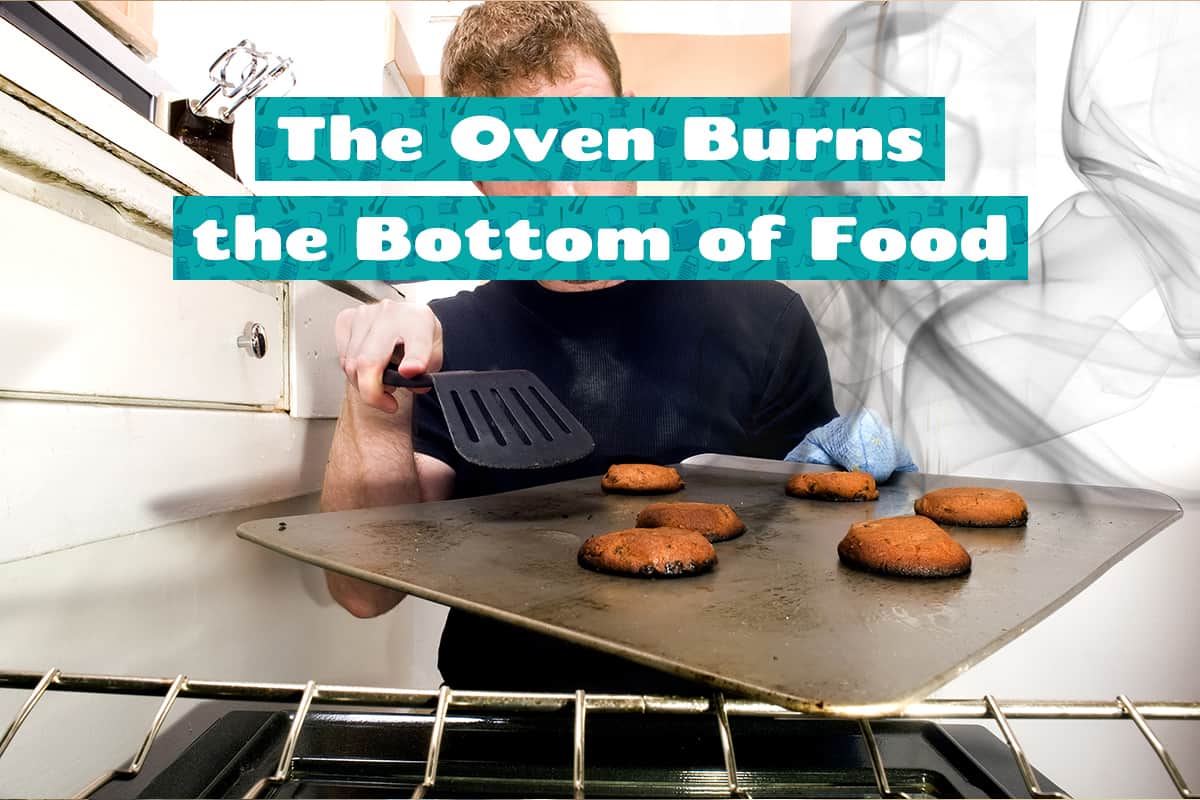You can do a lot with an oven, from baking cookies to roasting huge slabs of meat for parties. But one of the most annoying things your oven can do is burn the bottom of your food. All the hard work you put into preparing a delicious meal is gone for nothing! What’s causing this to happen?
There are a few common causes of why your oven burns the bottom of your food, such as:
- Inconsistent temperature control
- Misplaced oven racks
- Work-out or damaged heating elements
- Using the wrong bakeware
In this guide, we will look into the reasons behind this frustrating issue in more detail and offer step-by-step solutions and expert tips to help you always achieve perfect cooking.
Why Does Food Burn at the Bottom?
Imagine spending all week planning a meal for an upcoming party, and on the day of, you find that your beautiful roast is charred to a crisp at the bottom. Here, we’ll explore the various causes of why this happens so you can avoid it in the future.
1. Inconsistent Temperature Control
This refers to your oven’s inability to maintain a steady temperature throughout baking. Common in older models, heat may not be distributed evenly throughout the cooking chamber, leaving some of your baking dish burned while others are relatively cool and uncooked.
There are a few causes of this:
- Oven Thermostat Issues: If the thermostat is not calibrated correctly, you may inadvertently set your oven to a cooler temperature (e.g., 350°F), but the oven heats up to a higher temperature (450°F, for instance).
- Heat Source Location: If you fail to take care of your oven, the top burners may not produce as much heat as the bottom burners, leaving your food thoroughly burned underneath while the top remains lukewarm or even raw.
2. Misplaced Oven Racks
This has more to do with human error than the oven malfunctioning (nobody’s perfect). You may find at least two racks inside your oven—one closer to the bottom than the other. Usually, recipes will ask that you place the baking dish on the center rack, but if you place it too close to the heat source (i.e., the bottom rack), the bottom of the dish will heat up far sooner than the top can.
3. Worn-out or Damaged Heating Elements
The heating element in your oven is the source of heat. The heating element consists of a hollow tube that heats up with electricity (electric ovens) or a series of burners where live flames introduce heat into the oven (gas ovens).
If you don’t take care of your oven’s heating elements, they may heat your oven unevenly, leaving the top and sides of your dish raw while the bottom is burned to a crisp.
4. Using the Wrong Bakeware
You’ve probably heard of “oven-safe” bakeware before. Well, the term “oven-safe” isn’t just a suggestion; it’s a law that you should follow if you don’t want to ruin your baked dishes.
Certain materials, like aluminum, heat up more quickly than others, like ceramic. Any portion of your food in contact with the material will heat up quickly, long before the center or top has time to cook.
Step-by-step Solutions to Fix the Burning Problem

Nobody wants to waste time and ingredients on a meal that ends up burned at the bottom. If you’ve experienced this problem, don’t worry! We’ll provide step-by-step guides for fixing the issues discussed above.
1. Calibrating the Oven Thermostat
- Test with an Oven Thermometer: Place an oven thermometer inside, set your oven to a specific temperature, and compare it with the thermometer reading.
- Adjust if Necessary: Refer to the oven manual to learn how to calibrate the thermostat. You may need to turn a screw or make adjustments through a digital interface.
- Seek Professional Help if Needed: If calibration seems complex, contact a qualified technician to do it for you.
2. Properly Positioning the Oven Racks
- Follow Recipe Instructions: Always follow the recipe’s guidelines for rack positioning.
- Experiment if Needed: If unsure, place the rack in the middle of the oven for even heating.
- Avoid Placing Food Too Close to Heat Source: This helps prevent overcooking the bottom.
3. Replacing Worn-Out or Damaged Heating Elements
- Inspect the Elements Regularly: Look for signs of wear or damage. Look for clogs, cracks, gaping holes, or even caked-on debris.
- Purchase the Right Replacement: Make sure to buy the correct element for your oven model.
- Follow Replacement Instructions: Refer to your oven’s manual or seek professional help for replacing the element.
4. Choosing the Right Bakeware
- Understand Material Differences: Know which materials conduct heat best for your cooking needs.
- Avoid Dark-Colored or Thin Pans: These can cause the bottom to cook too quickly.
- Experiment with Different Types: Find what works best for your favorite recipes.
Best Type of Bakeware
The best type of bakeware for your oven depends on what you are cooking and the specific characteristics of your oven. Here’s a general guide to help you choose:
- Metal Pans: Light-colored metal pans are good for even heating. They are ideal for cakes, cookies, and pastries.
- Glass or Ceramic Dishes are excellent for casseroles and pies, as they retain heat well and cook food evenly. Be sure to reduce the oven temperature by 25°F when using glass, as it can cause food to brown more quickly.
- Silicone Bakeware: This type is flexible and non-stick, making it good for muffins and shaped cakes, but it may not brown food as effectively.






